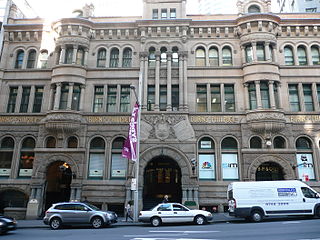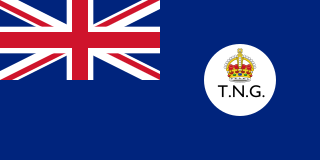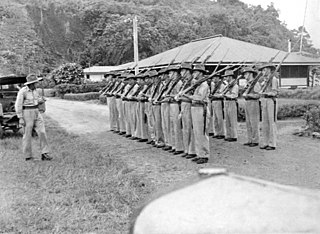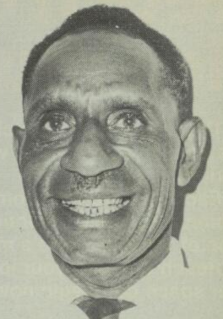| Total population | |
|---|---|
| 207 (2007) [1] | |
| Regions with significant populations | |
| Rabaul | |
| Languages | |
| Papuan languages, English, Japanese | |
| Religion | |
| Predominantly Roman Catholicism, Shintoism and Mahayana Buddhism [2] | |
| Related ethnic groups | |
| Papuans, Japanese |
Japanese settlement in the Territory of Papua and German New Guinea (in what now constitutes modern-day Papua New Guinea) dates back to the early 20th century when migrants from Japan established copra plantations and trading businesses in the islands, specifically Rabaul. The Japanese community remained small throughout the first half of the 20th century, although there were Japanese migrating in and out of New Guinea in different years from 1901 to 1945, it generally never exceeded more than 100 as a whole community. Some Japanese stayed for short terms and were replaced by newer emigrants from Japan, others stayed for longer periods depending on their roles. Most Japanese in Papua were businessmen and plantation managers, although a few became fishermen. As almost all the migrants were men, many of them married local Papuan wives and raised mixed-race Japanese-Papuan families while other Japanese men staying only for short periods also had sexual cohabitations with local Papuan women, but in most cases without marrying. Many of them did produce offspring but they were generally abandoned by their Japanese fathers (some of whom were already married with children in Japan) and raised by their single Papuan mothers or sent to the orphanage. These abandoned mixed-race children's were recorded as ethnic Papuans in the census as the ethnicity of their fathers was unknown.
During World War II, the Imperial Japanese Army invaded New Guinea with 350,000 troops and occupied most of its territory from January 1942 to August 1945. Some Papuan women including mixed-race Japanese-Papuan women were forced to become comfort women. Most Japanese in the unoccupied areas of New Guinea were deported to Australia where they were confined. The majority of them were repatriated to Japan after the war, although their mixed-race children were allowed to remain behind and assimilated with the local populace. [3] Official estimates show 207 Japanese-Papuan mixed descendants.
The first recorded Japanese presence in German New Guinea dates back to the beginning of the 20th century when a pearl diver, Isokichi Komine from Thursday Island in the Torres Strait Islands relocated to Rabaul in October 1901. Upon settling in Rabaul, Komine worked for its governor Albert Hahl in the plantation, trade and shipbuilding fields. Komine secured a thirty-year land lease from Hahl to build a shipyard on Rabaul in 1907, in addition to several other land concessions for copra plantation. At this time, Japanese migrants in Rabaul and the neighbouring islands joined Komine and worked for him. [4] Other migrants settled in Port Moresby and Samarai. When World War I broke out in 1914, Japanese settlers in Rabaul experienced political tension as relations between Germany and Japan weakened. When Japan declared war against Germany in 1914, Komine aligned with the Australians, but also maintained close ties with German businessmen to safeguard his business interests. A few more Japanese migrated to New Guinea between 1914 and 1918 and established new independent enterprises that competed with Komine's, consisting mainly of copra plantations, pearl diving and trade. One Japanese businessman, Imaizumi Masao diversified into the entertainment industry and set up a picture theatre, New Britain Pictures in 1916. [5]
Some of Japanese settlers who lived in the plantations occasionally suffered from tropical ailments including malaria, although fatalities were rare. In Rabaul's Chinatown, Japanese settlers became shopkeepers. Japanese settlers generally maintained cordial relations with the natives, and a sizeable majority intermarried with the natives from the 1910s onwards, although a few settlers brought their wives and families from Japan along. [5] In the 1920s and 1930s, Japanese immigration to New Guinea remained minimal, which was attributed to strict immigration laws that was imposed by the Australian colonial government and discouraged Japanese settlement in New Guinea. In 1932, the Japanese community formed a Japanese society at Rabaul and nominated Nagahama Taichi as its first president. The Japanese maintained contact with Japan through a regular trading ship which visited Rabaul through Pohnpei. Around the same time, children of the first Japanese settlers—usually offspring of Japanese fathers and Papuan mothers—inherited their father's business enterprises. [3]
A few Japanese left New Guinea between 1940 and 1941 in the Second World War, as Japanese reconnaissance planes were often spotted in New Guinea's skies, hinting at the prospect of a Japanese invasion. A trading ship from the South Seas Trading Company offered to help Japanese residents leave New Guinea, but some thirty-three Japanese chose to stay behind, ten of whom had raised local families during the interwar years. When reports of the attack on Pearl Harbor reached the Australian colonial administration on 8 December 1941, Japanese residents at Rabaul were immediately arrested and interned at the local jail, while the search and arrest for other Japanese residents in the neighbouring islands continued until May 1942. Indigenous spouses of Japanese residents as well as mixed-race Japanese children also faced similar fates as the other Japanese residents. When the Japanese captured Rabaul in January 1942, the Japanese residents who were interned were relocated to Sydney, although their native spouses and children were left behind. The former residents were joined by other Japanese prisoners-of-war from New Hebrides, New Caledonia and those from other parts of Australia. [2]
When the Japanese arrived in Rabaul in 1942, Japanese residents who were not captured welcomed the Japanese soldiers, who released the mixed-race Japanese from internment. Most of them initially held suspicions of the presence of Japanese military personnel, which was partly fuelled by the absence of their Japanese fathers who were relocated to concentration camps in Australia. During the Japanese occupation from 1942 to 1945, mixed-race Japanese children were conscripted to clerical or light menial work within the military administration, and some received a Japanese education. At least one mixed-race Japanese, Pius Kikuchi, described the treatment of the Japanese military administration to the mixed-race children as gentle but discipline-oriented in nature. In other areas of Papua New Guinea which remained under Australian control, families of Japanese residents generally received harsh treatment from the Australian military. [2] "Comfort women" formed another major component of the local Japanese community during the Japanese occupation years, which consisted of up to 3,000 Japanese and Korean women who were stationed in Rabaul's Chinatown which was frequented by Japanese military personnel. Apart from local Papuan women also serving as comfort women, one Australian Captain, David Hutchinson-Smith, also mentioned of some mixed-race, young Japanese-Papuan girls who were also conscripted as comfort women. [6]
After the Japanese surrender in 1945, former Japanese residents of Rabaul were automatically to be repatriated to Japan, and a debate ensued on the fate of ten former Japanese residents who had raised local families. Among the local populace, there was considerable anti-Japanese sentiment and graves of the first Japanese settlers were exhumed along with those of the Japanese soldiers and thrown into the sea. One Japanese resident was released from detention immediately after reaching Samarai. Another former resident, Izumi died of illness during internment and eight others were held under military custody until 1949 before they were deported to Japan. All eight former residents returned to Japan and realised that their assets in Japan and New Guinea were confiscated, although a few were able to re-integrate into the mainstream Japanese society. Some former residents maintained links with their native wives for a few years before remarrying in Japan, but none of them returned to Papua New Guinea throughout their remaining lives. The mixed-race Japanese assimilated with the local populace within a few years after the war and identified themselves as Papuans. [2]
A 1921 census counted 87 individuals, and the number of Japanese residents in New Guinea witnessed a decline until here were only 36 in 1940. Approximately one third were businessmen living in Rabaul, while the remainder were plantation managers and fishermen who lived mainly in Manus, New Ireland and Bougainville. In particular, a census done in 1933 counted 29 second-generation Japanese residents – these comprised mixed-race Japanese Papuans as well as a few full-blooded Japanese, and nine long-term Japanese residents in Papua. First-generation Japanese residents were mostly adherents of Shinto and Buddhism, although they generally avoided celebrating religious or cultural festivals in public. No Japanese Shinto or Buddhist shrines were built during the interwar years, and Japanese residents publicly celebrated Australian holidays to avoid rousing suspicion from the Australian authorities. Upon marrying a native wife, Japanese residents conduct their wedding ceremonies in Christian churches, and often send their children to Catholic Mission schools. Most mixed-race children were taught to speak Papuan languages and English from infancy, and had little knowledge of the Japanese language and customs. [3] During the Japanese occupation, mixed-race Japanese were taught in the Japanese language as well as its cultural customs. [2]

The prehistory of Papua New Guinea can be traced to about 50,000 - 60,000 years ago, when people first migrated towards the Australian continent. The written history began when European navigators first sighted New Guinea in the early part of the 17th century.

New Britain is the largest island in the Bismarck Archipelago, part of the Islands Region of Papua New Guinea. It is separated from New Guinea by a northwest corner of the Solomon Sea and from New Ireland by St. George's Channel. The main towns of New Britain are Rabaul/Kokopo and Kimbe. The island is roughly the size of Taiwan. While the island was part of German New Guinea, it was named Neupommern . In common with most of the Bismarcks it was largely formed by volcanic processes, and has active volcanoes including Ulawun, Langila, the Garbuna Group, the Sulu Range, and the volcanoes Tavurvur and Vulcan of the Rabaul caldera. A major eruption of Tavurvur in 1994 destroyed the East New Britain provincial capital of Rabaul. Most of the town still lies under metres of ash, and the capital has been moved to nearby Kokopo.

Rabaul is a township in the East New Britain province of Papua New Guinea, on the island of New Britain. It lies about 600 kilometres to the east of the island of New Guinea. Rabaul was the provincial capital and most important settlement in the province until it was destroyed in 1994 by falling ash from a volcanic eruption in its harbour. During the eruption, ash was sent thousands of metres into the air, and the subsequent rain of ash caused 80% of the buildings in Rabaul to collapse. After the eruption the capital was moved to Kokopo, about 20 kilometres (12 mi) away. Rabaul is continually threatened by volcanic activity, because it is on the edge of the Rabaul caldera, a flooded caldera of a large pyroclastic shield.

Kavieng is the capital of the Papua New Guinean province of New Ireland and the largest town on the island of the same name. The town is located at Balgai Bay, on the northern tip of the island. As of 2009, it had a population of 17,248.

The Battle of Rabaul, also known by the Japanese as Operation R, an instigating action of the New Guinea campaign, was fought on the island of New Britain in the Australian Territory of New Guinea, from 23 January into February 1942. It was a strategically significant defeat of Allied forces by Japan in the Pacific campaign of World War II, with the Japanese invasion force quickly overwhelming the small Australian garrison, the majority of which was either killed or captured. Hostilities on the neighbouring island of New Ireland are usually considered to be part of the same battle. Rabaul was significant because of its proximity to the Japanese territory of the Caroline Islands, site of a major Imperial Japanese Navy base on Truk.

Morobe Province is a province on the northern coast of Papua New Guinea. The provincial capital and largest city is Lae. The province covers 33,705 km2, with a population of 674,810, and since the division of Southern Highlands Province in May 2012 it is the most populous province. It includes the Huon Peninsula, the Markham River, and delta, and coastal territories along the Huon Gulf. The province has nine administrative districts. At least 101 languages are spoken, including Kâte and Yabem language. English and Tok Pisin are common languages in the urban areas, and in some areas pidgin forms of German are mixed with the native language.

The Vitu Islands are a volcanic group with an area of 37 sq mi (96 km²) located in the Bismarck Sea off New Britain, in the southwestern Pacific Ocean. They are not technically part of the Bismarck Archipelago. Administratively they are part of Papua New Guinea. Formerly called the French Islands, the group is sometimes known as the Witu Islands.

Goodenough Island in the Solomon Sea, also known as Nidula Island, is the westernmost of the three large islands of the D'Entrecasteaux Islands in Milne Bay Province of Papua New Guinea. It lies to the east of mainland New Guinea and southwest of the Trobriand Islands. It is roughly circular in shape, measuring 39 by 26 kilometres with an area of 687 square kilometres (265 sq mi) and a shoreline of 116 kilometres (72 mi). From a coastal belt varying in width from 2 to 10 kilometres in width, the island rises sharply to the summit of Mount Vineuo, 2,536 metres (8,320 ft) above sea level, making it one of the most precipitous islands in the world. The small outlier Wagifa Island lies to the south-east of the island, and is included within Goodenough's administration.

Rambutyo Island is one of the Admiralty Islands in the Bismarck Archipelago, located at 2°17′S147°49′E. Politically, Rambutyo Island is part of Manus Province, Papua New Guinea. The population (unknown) is concentrated on the west coast. Villages include Mouklen and Lengkau.

Burns Philp was once a major Australian shipping line and merchant that operated in the South Pacific. When the well-populated islands around New Guinea were targeted for blackbirding in the 1880s, a new rush for labour from these islands began. James Burns and Robert Philp purchased several well-known blackbirding ships to quickly exploit the human resource in this region, and Burns Philp entered the slave trade. The company ended its involvement in blackbirding in 1886. In later years the company was a major player in the food manufacturing business. Since its delisting from the Australian Securities Exchange in December 2006 and the subsequent sale of its assets, the company has mainly become a cashed up shell company. It is wholly owned by Graeme Hart's Rank Group.

The Territory of New Guinea was an Australian-administered United Nations trust territory on the island of New Guinea from 1914 until 1975. In 1949, the Territory and the Territory of Papua were established in an administrative union by the name of the Territory of Papua and New Guinea. That administrative union was renamed as Papua New Guinea in 1971. Notwithstanding that it was part of an administrative union, the Territory of New Guinea at all times retained a distinct legal status and identity until the advent of the Independent State of Papua New Guinea.

The New Guinea Volunteer Rifles (NGVR) was an infantry battalion of the Australian Army. It was initially raised as a unit of the Militia from white Australian and European expatriates in New Guinea upon the outbreak of the Second World War in 1939, before being activated for full-time service following the Japanese landings in early 1942. NGVR personnel then helped rescue survivors of Lark Force from Rabaul in February and March 1942. Between March and May, the NGVR monitored the Japanese bases which had been established in the Huon Gulf region, being the only Allied force in the area until the arrival of Kanga Force at Wau in May. The battalion subsequently established observation posts overlooking the main approaches and reported on Japanese movements.
Copra plantations in New Guinea have been cultivated since the late 19th century, originally by German colonialists. They were continued by Australian interests following World War II.
Chinese people in Papua New Guinea form a very diverse community. As of 2008, only about 1,000 of the "old Chinese"—locally born descendants of late 19th- and early 20th-century immigrants—remain in the country; most have moved to Australia. However, their numbers have been bolstered significantly by new arrivals from overseas Chinese communities in Southeast Asia and later from mainland China. There are also a few migrants from the Republic of China on Taiwan.
Japanese settlement in New Caledonia dates back to the 19th century when male indentured labourers were brought to the island and worked in the nickel mines. Some of whom settled down in New Caledonia, and often intermarried with women of other ethnicities. After the Second World War, most of the island's Japanese were repatriated back to Japan, although a small minority remained behind.
Isokichi Komine was an Australian pearl diver, merchant, and trader. One of German New Guinea's earliest emigrants, he is known as "one of Rabaul's oldest pioneers".

The Malahang Mission Station is a Lutheran filial station situated in Malahang, Morobe Province in Papua New Guinea now under the auspices of the Evangelical Lutheran Church of Papua New Guinea. The Mission station is located on Busu Road, Malahang opposite the Malahang Industrial Area.

As the township of Lae, in Morobe Province, Papua New Guinea is a relatively new entity, the history of the Lae environs is much older.

Donald Barrett was an Australian planter, army major, politician and sports coach in the Territory of Papua and New Guinea. He served as a member of the Legislative Council and House of Assembly in two spells between 1951 and 1968.

Sir Pita Simogun was a Papua New Guinean policeman, farmer and politician. He served as a member of the Legislative Council from 1951 to 1961 and then as a member of the House of Assembly from 1964 to 1968, during which time he was also Parliamentary Under-Secretary for Police.